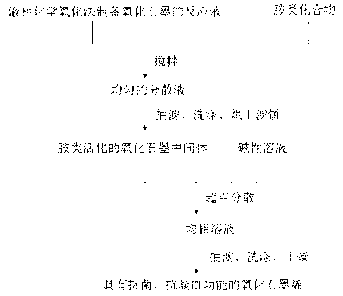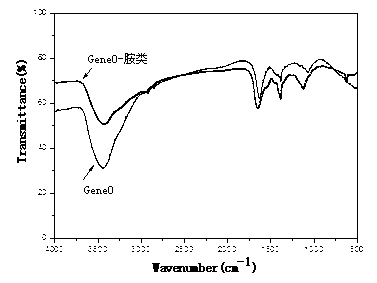Graphene oxide with antibacterial and anticoagulant functions and preparation method thereof
A graphene and anti-coagulation technology, applied in the field of graphene oxide nanomaterials, can solve problems such as restricting the application of graphene oxide, and achieve the effects of short preparation period, saving water resources, and reducing costs
- Summary
- Abstract
- Description
- Claims
- Application Information
AI Technical Summary
Problems solved by technology
Method used
Image
Examples
Embodiment 1
[0041] Utilize the Brodie method to prepare graphite oxide, the reaction solution does not carry out aftertreatment; Add 5% pyridine compound in the reaction solution of the prepared graphite oxide, wherein, the mass of graphite oxide and the volume ratio of pyridine compound are 1:10, adjust pH to neutral After stirring and reacting at 0°C for 1 hour, a uniform dispersion liquid is formed; the dispersion liquid is suction-filtered, washed until the filtrate is neutral, and the filter cake is dried to obtain an intermediate product of pyridine-activated graphite oxide. Dissolve the graphite oxide intermediate product activated by pyridine amines with 0.1% sodium hydroxide solution, and disperse it ultrasonically for 5 hours to obtain a homogeneous solution; filter the solution with suction, wash until the filtrate is neutral, and dry the filter cake in vacuum at 30°C for 3 days to obtain Graphene oxide with antibacterial and anticoagulant functions.
Embodiment 2
[0043] Utilize the Brodie method to prepare graphite oxide, the reaction solution is not post-treated; add 50% ammonia water to the reaction solution of the prepared graphite oxide, wherein the mass of graphite oxide and the volume ratio of the pyridine compound are 1:100, adjust the pH to neutral , after stirring and reacting at 30° C. for 5 hours, a uniform dispersion liquid was formed; the dispersion liquid was suction-filtered, washed until the filtrate was neutral, and the filter cake was dried to obtain an ammonia-activated graphite oxide intermediate product. Dissolve the ammonia-activated graphite oxide intermediate product with 5% potassium hydroxide solution, and disperse it ultrasonically for 0.5 h to obtain a homogeneous solution; filter the solution with suction, wash until the filtrate is neutral, and dry the filter cake in vacuum at 100°C for 3 h to obtain an antibacterial , Graphene oxide with anticoagulant function.
Embodiment 3
[0045] Utilize the Brodie method to prepare graphite oxide, the reaction solution is not post-treated; add 10% dimethylamine to the reaction solution of the prepared graphite oxide, wherein the mass of graphite oxide and the volume ratio of dimethylamine are 1:20, adjust the pH To neutrality, after stirring and reacting at 10°C for 2 hours, a uniform dispersion liquid is formed; the dispersion liquid is suction-filtered, washed until the filtrate is neutral, and the filter cake is dried to obtain an intermediate product of graphite oxide activated by dimethylamine. Dissolve the graphite oxide intermediate product activated by dimethylamine with 0.2% sodium hydroxide solution, and ultrasonically disperse it for 2 hours to obtain a homogeneous solution; filter the solution with suction, wash until the filtrate is neutral, and dry the filter cake in vacuum at 30°C for 2 days to obtain Graphene oxide with antibacterial and anticoagulant functions.
PUM
| Property | Measurement | Unit |
|---|---|---|
| thickness | aaaaa | aaaaa |
Abstract
Description
Claims
Application Information
 Login to View More
Login to View More - R&D
- Intellectual Property
- Life Sciences
- Materials
- Tech Scout
- Unparalleled Data Quality
- Higher Quality Content
- 60% Fewer Hallucinations
Browse by: Latest US Patents, China's latest patents, Technical Efficacy Thesaurus, Application Domain, Technology Topic, Popular Technical Reports.
© 2025 PatSnap. All rights reserved.Legal|Privacy policy|Modern Slavery Act Transparency Statement|Sitemap|About US| Contact US: help@patsnap.com



